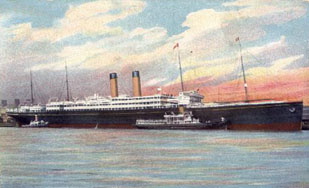RMS Baltic (1903)

| |
| Career | |
|---|---|
| Name: | RMS Baltic |
| Owner: | White Star Line |
| Route: | Liverpool to New York City |
| Builder: | Harland and Wolff, Belfast |
| Launched: | 21 November 1903 |
| Maiden voyage: | 29 June 1904 |
| Fate: | Scrapped in Osaka, Japan; sailed there 17 February 1933 |
| General characteristics | |
| Tonnage: | 23,876 GT (gross tonnage) |
| Length: | 729 feet (222.7 m) |
| Beam: | 75.6 feet (23.1 m) |
| Propulsion: | Two four-cylinder quadruple expansion engines powering two propellers. |
| Speed: | 16 knots |
| Capacity: | 2,875 people |
RMS Baltic was the second ship of that name belonging to the White Star Line. At 23,876 gross tons, she was the largest ship in the world until 1905. She was the third of a quartet of ships, all measuring over 20,000 gross tons, dubbed The Big Four (the other three being RMS Celtic, Cedric, and Adriatic).
She was launched on 21 November 1903 by Harland and Wolff at Belfast and sailed from Liverpool on her maiden voyage to New York on 29 June 1904 with Captain Edward Smith in command.
On 23 January 1909 (commanded by J. B. Ranson) she rescued survivors of the collision in fog between the White Star Line's RMS Republic and the SS Florida off the north eastern coast of the U.S., after which Republic sank.
In April 1912 Baltic sent ice warnings to the RMS Titanic before that ship sank. Edward Smith, Baltic's first captain; in 1912, captain of Titanic.
She was also involved in a rescue on 6 December 1929, when she assisted the sinking schooner Northern Light.
On 17 February 1933, she sailed for Osaka, Japan where she was scrapped.
World War Steaming Schedule
One of RMS Baltic's first major events during the World War was having been chosen to deliver Major General John J. Pershing and his staff to England. On 9 June 1917, the War Department released its first communique revealing the arrival of General Pershing in England, and this was published as follows:
"Baltic Carried Pershing Over. Londoners Preparing to Entertain American Soldiers. 10 U.S. Airmen in France. Pershing's Personal Staff and Other Members of General Staff Number 67 Officers and Are Accompanied by a Squad of 50 Privates and a Large Civilian Clerical Force- Pershing Anxious to Get into Harness. London, June 9.- Headed by Major General John J. Pershing, its commander, the first representation of the American army that is to enter the European war disembarked at a British port after an uneventful voyage of 10 day on board the White Star line Baltic. The party was received with full military honors and immediately entrained for London, where it arrived and was welcomed by the Earl of Derby, the minister of war; Viscount French commander of the British forces, and the American officials..."[1]
References
- ↑ "Baltic Carried Pershing Over". Dunkirk Evening Observer (June 9, 1917), p 3, column 2.
External links
| |||||
| |||||||||||
cs:RMS Baltic (1903) de:Baltic (1903) fr:RMS Baltic fi:RMS Baltic
